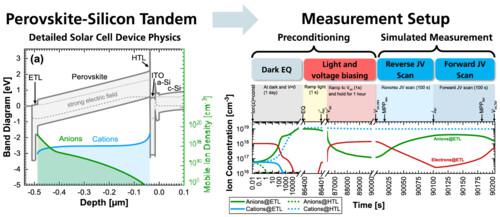当前位置:
X-MOL 学术
›
Prog. Photovoltaics
›
论文详情
Our official English website, www.x-mol.net, welcomes your feedback! (Note: you will need to create a separate account there.)
Toward more reliable measurement procedures of perovskite-silicon tandem solar cells: The role of transient device effects and measurement conditions
Progress in Photovoltaics ( IF 6.7 ) Pub Date : 2024-02-11 , DOI: 10.1002/pip.3782 Christoph Messmer 1, 2 , David Chojniak 2 , Alexander J. Bett 2 , S. Kasimir Reichmuth 1, 2 , Jochen Hohl‐Ebinger 2 , Martin Bivour 2 , Martin Hermle 2 , Jonas Schön 1, 2 , Martin C. Schubert 2 , Stefan W. Glunz 1, 2
Progress in Photovoltaics ( IF 6.7 ) Pub Date : 2024-02-11 , DOI: 10.1002/pip.3782 Christoph Messmer 1, 2 , David Chojniak 2 , Alexander J. Bett 2 , S. Kasimir Reichmuth 1, 2 , Jochen Hohl‐Ebinger 2 , Martin Bivour 2 , Martin Hermle 2 , Jonas Schön 1, 2 , Martin C. Schubert 2 , Stefan W. Glunz 1, 2
Affiliation

|
Perovskite-silicon (Pero-Si) tandem solar cells have made remarkable progress in recent years, achieving certified cell efficiencies of up to 33.9%. However, accurately measuring the efficiency and current density-voltage (JV) curves of these devices poses various challenges including the presence of mobile ions within the perovskite absorber that lead to short- and long-term transient effects. Consequently, both the measurement setup and the preconditioning of the device significantly affect measurement results. This study focuses on enhancing the reliability and comparability of JV and other efficiency measurements for Pero-Si tandem devices through a systematic analysis of the influence of mobile ions, preconditioning and measurement conditions. For the first time, a full opto-electrical simulation model for Pero-Si tandem devices is presented in Sentaurus TCAD, which includes the drift-diffusion of anions and cations and is therefore able to describe short- and long-term transient device effects in state-of-the-art Pero-Si tandem cells. Experimental validation and evidence are given by comparison to in-house Pero-Si tandem cells, as well as Pero-Si mini modules from Oxford PV. We analyze by simulation and experiment how the cell preconditioning at different preconditioning voltages and times impacts the resulting measured tandem efficiency, as well as impact of JV scan times for the measured hysteresis in Pero-Si tandem devices. Furthermore, we demonstrate the impact of current-mismatching conditions on the measured hysteresis of the Pero-Si tandem device and the need of correct spectral irradiance settings during measurements. We showcase that even a very slight variation in short-circuit current density (jsc) around the current-matching point leads to significantly different hysteresis behaviors. With aid of our simulation model, we could attribute this phenomenon to a reverse/forward biasing of the perovskite sub-cell impacting the ion drift depending on the current-limiting sub-cell of the tandem device. Therefore, it is sensible to be aware of the current limiting sub-cell for the comparison of the hysteresis susceptibility of different Pero-Si tandem devices. This study strongly underscores the importance of including the preconditioning and measurement conditions when reporting Pero-Si tandem efficiencies. The findings highlight the urgent need for standardization in the field.
中文翻译:

实现更可靠的钙钛矿-硅串联太阳能电池测量程序:瞬态器件效应和测量条件的作用
近年来,钙钛矿-硅 (Pero-Si) 串联太阳能电池取得了显着进展,经认证的电池效率高达 33.9%。然而,准确测量这些器件的效率和电流密度-电压 ( JV ) 曲线带来了各种挑战,包括钙钛矿吸收剂中存在移动离子,从而导致短期和长期瞬态效应。因此,设备的测量设置和预处理都会显着影响测量结果。本研究的重点是通过系统分析移动离子、预处理和测量条件的影响,提高 Pero-Si 串联器件JV和其他效率测量的可靠性和可比性。 Sentaurus TCAD 首次提出了 Pero-Si 串联器件的完整光电仿真模型,其中包括阴离子和阳离子的漂移扩散,因此能够描述短期和长期瞬态器件效应最先进的 Pero-Si 串联电池。通过与内部 Pero-Si 串联电池以及 Oxford PV 的 Pero-Si 迷你模块进行比较,给出了实验验证和证据。我们通过仿真和实验分析了不同预处理电压和时间下的电池预处理如何影响所测量的串联效率,以及JV扫描时间对 Pero-Si 串联器件中所测量的磁滞的影响。此外,我们还演示了电流失配条件对 Pero-Si 串联器件测量迟滞的影响,以及测量期间正确光谱辐照度设置的需要。我们证明,即使电流匹配点周围的短路电流密度 ( j sc ) 发生非常微小的变化,也会导致显着不同的磁滞行为。借助我们的模拟模型,我们可以将这种现象归因于钙钛矿子电池的反向/正向偏置影响离子漂移,具体取决于串联器件的限流子电池。因此,为了比较不同 Pero-Si 串联器件的磁滞敏感性,了解限流子电池是明智的。这项研究强烈强调了在报告 Pero-Si 串联效率时包括预处理和测量条件的重要性。研究结果凸显了该领域标准化的迫切需要。
更新日期:2024-02-13
中文翻译:

实现更可靠的钙钛矿-硅串联太阳能电池测量程序:瞬态器件效应和测量条件的作用
近年来,钙钛矿-硅 (Pero-Si) 串联太阳能电池取得了显着进展,经认证的电池效率高达 33.9%。然而,准确测量这些器件的效率和电流密度-电压 ( JV ) 曲线带来了各种挑战,包括钙钛矿吸收剂中存在移动离子,从而导致短期和长期瞬态效应。因此,设备的测量设置和预处理都会显着影响测量结果。本研究的重点是通过系统分析移动离子、预处理和测量条件的影响,提高 Pero-Si 串联器件JV和其他效率测量的可靠性和可比性。 Sentaurus TCAD 首次提出了 Pero-Si 串联器件的完整光电仿真模型,其中包括阴离子和阳离子的漂移扩散,因此能够描述短期和长期瞬态器件效应最先进的 Pero-Si 串联电池。通过与内部 Pero-Si 串联电池以及 Oxford PV 的 Pero-Si 迷你模块进行比较,给出了实验验证和证据。我们通过仿真和实验分析了不同预处理电压和时间下的电池预处理如何影响所测量的串联效率,以及JV扫描时间对 Pero-Si 串联器件中所测量的磁滞的影响。此外,我们还演示了电流失配条件对 Pero-Si 串联器件测量迟滞的影响,以及测量期间正确光谱辐照度设置的需要。我们证明,即使电流匹配点周围的短路电流密度 ( j sc ) 发生非常微小的变化,也会导致显着不同的磁滞行为。借助我们的模拟模型,我们可以将这种现象归因于钙钛矿子电池的反向/正向偏置影响离子漂移,具体取决于串联器件的限流子电池。因此,为了比较不同 Pero-Si 串联器件的磁滞敏感性,了解限流子电池是明智的。这项研究强烈强调了在报告 Pero-Si 串联效率时包括预处理和测量条件的重要性。研究结果凸显了该领域标准化的迫切需要。



























 京公网安备 11010802027423号
京公网安备 11010802027423号